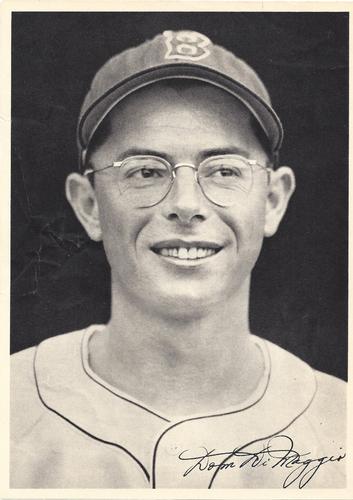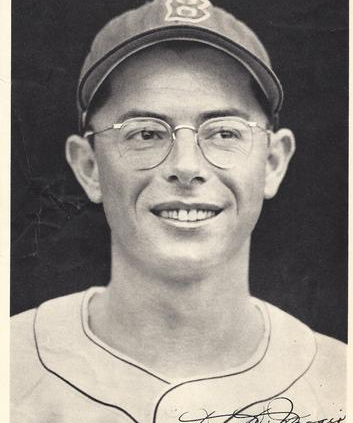August 9, 1949: Ted Williams hits 250th home run; Dom DiMaggio’s 34-game hitting streak halted by brother Joe
 This was a year in which every game between the New York Yankees and Boston Red Sox took on extra meaning as September came to a close. The two teams ended up tied going into the final game of the regular season. On August 9, however, New York had a 6½-game lead over third-place Boston. The Red Sox were just a half-game behind the Cleveland Indians.
This was a year in which every game between the New York Yankees and Boston Red Sox took on extra meaning as September came to a close. The two teams ended up tied going into the final game of the regular season. On August 9, however, New York had a 6½-game lead over third-place Boston. The Red Sox were just a half-game behind the Cleveland Indians.
It was Tuesday night at Fenway Park. The park was filled, and then some, with 35,091 admissions. Red Sox manager Joe McCarthy gave the starting assignment to Ellis Kinder, whose record so far in 1949 was 12-5. The Yankees starter for Casey Stengel was Vic Raschi, 15-6.
Right fielder Hank Bauer, the third man up for New York, singled to center field. He was the only batter for either team to reach base in the first inning. Raschi struck out Ted Williams for the third out in Boston’s first inning.
Kinder retired the three Yankees batters he faced in the second. The Red Sox, however, put runs on the board. Shortstop Vern Stephens led off with a four-pitch walk. Two outs followed, but after making the second out by forcing Stephens at second, Yankees shortstop Phil Rizzuto threw the ball into the Red Sox dugout and Billy Goodman (Boston’s first baseman) wound up on second base. Right fielder Al Zarilla doubled into right-center field and Goodman scored. Catcher Birdie Tebbetts then hit a “rising line drive into the left field screen,”1 a home run and it was 3-0, Red Sox. Kinder struck out.
Once more, Kinder got outs from the three Yankees who batted in the third. He struck out Raschi.
Center fielder Dom DiMaggio led off the bottom of the third inning with a fly ball to his brother Joe DiMaggio in center field. Johnny Pesky doubled to left field. Ted Williams hit a two-run homer to right field – “a direct line into the Red Sox bullpen”2 – giving the Red Sox a 5-0 lead.
It was the 250th home run of Williams’s major-league career. He was the 14th player in the American or National League to reach that milestone. Among active players, only Johnny Mize (315) and Joe DiMaggio (313) had more.
Joe DiMaggio singled in the Yankees fourth but was the only Yankee to get on base. Joe D.’s hit struck high off the left-field wall, missing a home run by maybe a foot, “bouncing back so quickly he had to settle for a single.”3
Now it was Raschi’s turn to set down the side in order. He struck out Kinder again.
New York got one run in the fifth. Left fielder Johnny Lindell singled to lead off. He was forced at second base by a grounder hit by the Yankees’ second baseman, Jerry Coleman. After catcher Charlie Silvera – in the lineup because Yogi Berra was out with a fractured left thumb4 – flied out to Williams in left field, Raschi hit a double to center field, scoring Coleman. Rizzuto singled off Pesky’s glove, Raschi could have scored from second base, but “stumbled rounding third, held up at the bag and never got any further.”5 Kinder got third baseman Bobby Brown to lift a fly ball to Pesky at third base.
Williams singled in the bottom of the fifth – to third base. No one else from the Red Sox contributed offense.
Hank Bauer led off the New York sixth with a home run over the left-field wall and into the screen, just inside the left-field foul pole. Kinder got the next three batters. The score was 5-2. Zarilla hit a two-out single in Boston’s half of the sixth, but that was all for the Red Sox.
Coleman singled to right field to lead off the seventh. Silvera flied out to right. Raschi got on base again, this time with a base on balls. With runners on first and second, Rizzuto flied out to center. Bobby Brown hit a single to second base, but Raschi was put out at second base on the play. One surmises he overran the bag and was tagged out by second baseman Bobby Doerr. Inning over.
Johnny Pesky singled to left field with two outs in the Red Sox seventh, but Williams grounded out to first base unassisted.
In the top of the eighth inning, Bauer did the very same thing he did leading off the sixth inning. He hit a solo home run, this one over everything in left-center field. Kinder retired the next three, but the Yankees had shaved down what had once been a 5-0 lead to 5-3.
In the Red Sox’ half, Stephens flied out to right field and Doerr struck out. Billy Goodman drew a walk. Zarilla doubled to center field and the Red Sox had runners on second and third. Birdie Tebbetts walked and the bases were loaded. Kinder was up. He hit the ball back to the Yankees pitcher, “a freak hit off Raschi’s glove, the ball rolling almost back to the plate while Goodman streaked home” with the sixth Red Sox run.6
Dom DiMaggio hit another fly ball to his brother Joe in center. With that out, Dom was 0-for-5 in the game and his 34-game hitting streak had come to an end.7 Through the 2023 season, he still held the Red Sox record for a player hitting in consecutive games.
Kinder had a 6-3 lead heading into the top of the ninth. He put the first man on, walking Coleman. Charlie Keller pinch-hit for Charlie Silvera. He hit a fly ball to center field. One out. Gene Woodling pinch-hit for Raschi. He struck out. Two outs. Rizzuto singled to center field, Coleman going to second base. Bobby Brown was up, with Bauer on deck and Joe DiMaggio after Bauer. Brown lifted a fly ball to Billy Goodman at first base and the game was over.
The Sox won, 6-3, Ellis Kinder improving his record to 13-5, Williams driving in the fourth and fifth runs of the game after Pesky doubled in the bottom of the third. Williams “parked his 28th homer of the year into the Red Sox bullpen in right-center.”8
With this win, the Red Sox had won 26 of their last 34 games. On the Fourth of July, they had been 12 games behind the Yankees. Now the gap had closed to 5½.
This was the first home run Williams had hit off Raschi. The first homer he hit in 1950 was off Raschi, too, another game-winning homer, on April 19 at Fenway Park.9 Later that season, he hit two more, career homers 292 and 293, both on September 24 at Yankee Stadium. And Williams’s home run 321 won a third game at Raschi’s expense, on September 5, 1951, also at Yankee Stadium.
Acknowledgments
This article was fact-checked by Joseph Wancho and copy-edited by Len Levin.
Photo credit: Dominic DiMaggio, Trading Card Database.
Sources
In addition to the sources cited in the Notes, the author consulted Baseball-Reference.com and Retrosheet.org.
https://www.baseball-reference.com/boxes/BOS/BOS194908090.shtml
https://www.retrosheet.org/boxesetc/1949/B08090BOS1949.htm
Notes
1 Jack Barry, “Sox Beat Yankees, 6-3; Dom Hitless,” Boston Globe, August 10, 1949: 1, 20.
2 Barry.
3 Ed Rumill, “Ellis Kinder Among Top RIght-Handers,” Christian Science Monitor (Boston), August 10, 1949: 12.
4 Tommy Henrich had to sit out the game, too, having been hit on the arm a couple of days before; Billy Johnson replaced him at first.
5 John Drebinger, “Homers by Williams and Tebbetts Sink Bombers for Red Sox, 6 to 3,” New York Times, August 10, 1949: 28.
6 Drebinger.
7 The next day a column by George C. Carens looked at the end of the streak in detail. See “Dom Went Down with Head Up,” Boston Traveler, August 10, 1949: 23.
8 Arthur Sampson, “Sox Defeat Yankees, 6-3; Tebbetts, Williams Homer,” Boston Herald, August 10, 1949: 24.
9 A “game-winning home run” is defined here as a home run that provides a game’s final margin of victory, giving the winning team at least one more run than the opposing team scored. For example, if a two-run homer increased a team’s lead from 2-1 to 4-1, and it went on to win 4-3, it qualifies as a game-winning home run. (This is different from the definition of “game-winning RBI” in baseball’s official statistics from 1980 through 1988, which counted as “game-winning” the RBI that provided a winning team the lead that it never relinquished.)
Additional Stats
Boston Red Sox 6
New York Yankees 3
Fenway Park
Boston, MA
Box Score + PBP:
Corrections? Additions?
If you can help us improve this game story, contact us.


